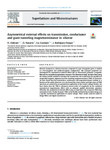
Please use this identifier to cite or link to this item:
http://ricaxcan.uaz.edu.mx/jspui/handle/20.500.11845/616Full metadata record
| DC Field | Value | Language |
|---|---|---|
| dc.contributor | 39945 | es_ES |
| dc.contributor.other | https://orcid.org/0000-0003-0087-8991 | - |
| dc.coverage.spatial | Global | es_ES |
| dc.creator | Outmane, Oubram | - |
| dc.creator | Navarro, Oracio | - |
| dc.creator | Rodríguez Vargas, Isaac | - |
| dc.creator | Guzmán, E. J. | - |
| dc.date.accessioned | 2018-08-08T16:36:57Z | - |
| dc.date.available | 2018-08-08T16:36:57Z | - |
| dc.date.issued | 2018-01 | - |
| dc.identifier | info:eu-repo/semantics/publishedVersion | es_ES |
| dc.identifier.issn | 0749-6036 | es_ES |
| dc.identifier.uri | http://hdl.handle.net/20.500.11845/616 | - |
| dc.identifier.uri | https://doi.org/10.48779/kd8v-rn71 | - |
| dc.description.abstract | Electron transport in a silicene structure, composed of a pair of magnetic gates, is studied in a ferromagnetic and antiferromagnetic configuration. The transport properties are investigated for asymmetrical external effects like an electrostatic potential, a magnetic field and for asymmetrical geometric structure. This theoretical study, has been done using the matrix transfer method to calculate the transmission, the conductance for parallel and antiparallel magnetic alignment and the tunneling magnetoresistance (TMR). In Particular, we have found that the transmission, conductance and magnetoresistance oscillate as a function of the width of barriers. It is also found that a best control and high values of TMR spectrum are achieved by an asymmetrical application of the contact voltage. Besides, we have shown that the TMR is enhanced several orders of magnitude by the combined asymmetrical magnetization effect with an adequate applied electrostatic potential. Whereby, the asymmetrical external effects play an important role to improve TMR than symmetrical ones. Finally, the giant TMR can be flexibly modulated by incident energy and a specific asymmetrical application of control voltage. These results could be useful to design filters and digital nanodevices. | es_ES |
| dc.language.iso | eng | es_ES |
| dc.publisher | Elsevier | es_ES |
| dc.relation | https://reader.elsevier.com/reader/sd/5560822F686E369864D0FEB36B11A45D277D586CA3B0266876D8870272619927BD38D2A5ADBD6E87DC6AC4B5B4B01975 | es_ES |
| dc.relation.ispartof | https://www.sciencedirect.com/science/article/pii/S0749603617315744?via%3Dihub | es_ES |
| dc.relation.uri | generalPublic | es_ES |
| dc.rights | Atribución-NoComercial-CompartirIgual 3.0 Estados Unidos de América | * |
| dc.rights.uri | http://creativecommons.org/licenses/by-nc-sa/3.0/us/ | * |
| dc.source | Volume 113, January 2018, Pages 483-496 | es_ES |
| dc.subject.classification | CIENCIAS FISICO MATEMATICAS Y CIENCIAS DE LA TIERRA [1] | es_ES |
| dc.subject.other | Tunneling magnetoresistance | es_ES |
| dc.subject.other | Silicene | es_ES |
| dc.subject.other | Asymmetrical effects | es_ES |
| dc.subject.other | Conductance | es_ES |
| dc.subject.other | Electron transport | es_ES |
| dc.title | Asymmetrical external effects on transmission, conductance and giant tunneling magnetoresistance in silicene | es_ES |
| dc.type | info:eu-repo/semantics/article | es_ES |
| Appears in Collections: | *Documentos Académicos*-- UA Física | |
Files in This Item:
| File | Description | Size | Format | |
|---|---|---|---|---|
| Asymmetrical external effects on transmission, conductance and giant tunneling magnetoresistance in silicene.pdf | 3,31 MB | Adobe PDF |  View/Open |
This item is licensed under a Creative Commons License
